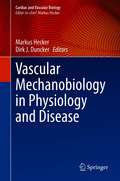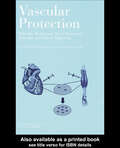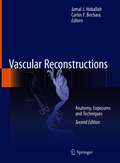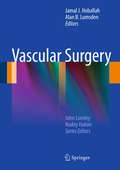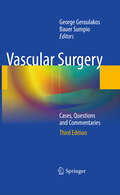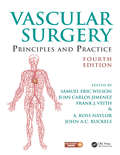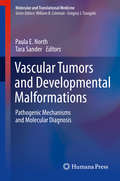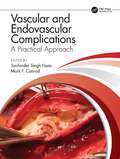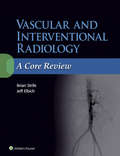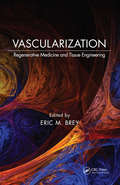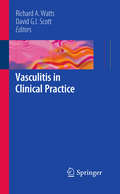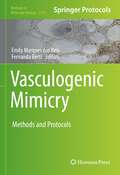- Table View
- List View
Vascular Mechanobiology in Physiology and Disease (Cardiac and Vascular Biology #8)
by Markus Hecker Dirk J. DunckerThis volume of the series Cardiac and Vascular Biology presents the most relevant aspects of vascular mechanobiology along with many more facets of this fascinating, timely and clinically highly relevant field. Mechanotransduction, mechanosensing, fluid shear stress, hameodynamics and cell fate, are just a few topics to name. All important aspects of vascular mechanobiology in health and disease are reviewed by some of the top experts in the field. This volume, together with a second title on cardiac mechanobiology featured in this series, will be of high relevance to scientists and clinical researchers in the area of vascular biology, cardiology and biomedical engineering.
Vascular Morphogenesis
by Domenico RibattiVascular Morphogenesis: Methods and Protocols provides a range of techniques for studying vascular morphogenesis in vivo and in vitro, reflecting advances in the field. Endothelial cell signaling is currently believed to promote fundamental cues for cell fate specification, embryo patterning, organ differentiation and postnatal tissue remodeling. Understanding the concept of vascular bed specificity represents a major challenge for future investigations. Indeed, one of the most interesting theoretical perspectives and practical applications of endothelial cell signaling is the possibility for these cells to maintain their inductive potential during adult life. Written in the highly successful Methods in Molecular Biology series format, chapters include introductions to their respective topics, lists of the necessary materials, step-by-step, readily reproducible laboratory protocols and tips on troubleshooting and avoiding known pitfalls. Practical and authoritative, Vascular Morphogenesis: Methods and Protocols will serve as a instructive and useful reference for cell biologists, anatomists, pathologists and physiologists, as well as all those interested in this area of biological study.
Vascular Neurology Board Review
by Hardik P. Amin Joseph L. SchindlerThis concise, yet comprehensive review covers the diagnostic and treatment information needed for the vascular neurology board exam. The assembled material is easy-to-read with chapters emphasizing clinically relevant scientific principles that must be mastered by the stroke clinician. Neurology, vascular neurology and neuro-critical care residents and fellows will find this text to be an invaluable preparation guide and a succinct source to complement treatment guidelines and protocols.
Vascular Neurology Board Review: An Essential Study Guide
by Hardik P. Amin Joseph L. SchindlerThis book provides a concise review for practitioners in preparation for the Vascular Neurology Boards including the Maintenance of Certification exam. This valuable second edition is expertly written and supplemented with new treatment paradigms as well as new and updated trial results.. Beginning with a general overview on how to prepare for the exam, this practical guide emphasizes clinically relevant scientific principles that must be mastered by the stroke clinician. Subsequent chapters review acute management of ischemic and hemorrhagic stroke, specific epidemiological risk factors, stroke pathophysiology, stroke classification, and vascular neuroanatomy. This edition also reviews cardiac and hematological considerations in stroke patients, genetic stroke syndromes, vascular malformations, cognitive disorders, stroke rehabilitation, and peri-operative stroke management. Vascular Neurology Board Review, Second Edition, is not only written to act as a guide for the neurology resident and fellow, but also as a useful framework for non-neurologists.
Vascular Neurosurgery
by Samer S. HozThis book is a guide dedicated to vascular pathologies affecting the central nervous system. It uses a multiple-choice format with more than 340 genuine MCQs in a convenient format that is ideal for self-study. Seven chapters provide comprehensive coverage of core concepts in vascular neurosurgery. The questions are structured and organized so as to offer a step-by-step description of each disease, from the definition, related anatomy, pathology, clinical features, radiology to surgical decisions and operative tricks. Answers and explanations appear directly below the questions to make reading easy. This book is essential for residents across neurosurgical disciplines as it includes most of the neurovascular information neurosurgical residents need to prepare for their certification exam. It is also beneficial for those seeking a refresher or for those preparing for certification maintenance.
Vascular Neurosurgery in Environments with Limited Resources
by Athanasios K. Petridis Homajoun MaslehatyEmbark on a transformative journey with this groundbreaking guide tailored for seasoned neurosurgeons in developed countries. This book serves as a compass for those inspired to extend their expertise to resource-constrained settings, elevating the standards of cerebrovascular surgery in developing nations. Beyond surgical techniques, it addresses intercultural nuances, language barriers, and the challenges of bridging the medical divide. This is not just a guide; it's a call to action, urging experts to actively share their knowledge with neurosurgeons in less privileged environments.
Vascular Protection: Molecular Mechanisms, Novel Therapeutic Principles and Clinical Applications
by Victor J. Dzau Gabor M. Rubanyi John P. CookeVascular Protection explores advances in vascular biology and how they translate into innovations in drug therapy for vascular disease. It addresses recent advances in the knowledge of endothelial vasoactive factors and other biologically active molecules as well as gene therapy. Written by leading experts in their respective fields, each chapter e
Vascular Proteomics
by Fernando VivancoProteomics is a rapidly expanding investigation platform in cardiovascular medicine. Driven by major improvements in mass spectrometry (MS) instrumentation and data analysis, the proteomics field has flourished in recent years particularly in the study of complex diseases. These recent advances are characterized by the development of quantitative MS-based methods that promoted the field from primarily identifying proteins to also providing measurements of relative changes in protein levels between different cell states. This progress is reflected in the application of proteomic techniques to vascular pathology. Vascular Proteomics: Methods and Protocols provides up-to-date methods and protocols for the analysis of arteries, cells, lipoproteins, body fluids, and metabolites, with a particular focus on MS-based methods of protein and peptide quantification. Written in the successful Methods in Molecular BiologyTM series format, chapters include introductions to their respective topics, lists of the necessary materials and reagents, step-by-step, readily reproducible protocols, and notes on troubleshooting and avoiding known pitfalls. Authoritative and easily accessible, Vascular Proteomics: Methods and Protocols is a representative selection of methods that can be a useful resource for experienced proteomics practitioners as well as newcomers interested in becoming acquainted with the practice of proteomic techniques for cardiovascular research.
Vascular Reconstructions: Anatomy, Exposures and Techniques
by Jamal J. Hoballah Carlos F. BecharaWhen the first edition of Vascular Reconstructions was published almost twenty years ago, endovascular surgery was still in its infancy. Endovascular approaches became the preferred initial intervention for many vascular pathologies resulting in a major decrease in open vascular surgical procedures. In order to build upon changes in the management of vascular pathology over the past two decades, this second edition of Vascular Reconstructions was conceived. The first part starts with a review of commonly used vascular instruments and an overview of grafts and sutures used in vascular reconstructions. A detailed chapter on vascular anatomy and exposures is provided to serve as a quick reference before starting a vascular procedure. The remaining chapters in the first part of this book review the basic steps usually performed before and after constructing a vascular anastomosis in addition to thrombectomy and endarterectomy. The second part of this book focuses on the various methods used to conduct a vascular reconstruction, which include primary closure, closure with a patch angioplasty, end-to-end, end-to-side, and side- to-side anastomoses. The various possible modifications used are outlined. The third part of this book reviews the various adjunctive methods used when constructing the proximal or distal anastomoses of an infrainguinal bypass. The fourth part of the book reviews the various modifications that are carried out when constructing the proximal and distal anastomoses of an aortic occlusive or aneurysmal pathology. The vascular anastomoses workshop that inspired the conception of this book is included as an appendix. The fifth part focuses on endovascular therapy and imaging.Vascular Reconstructions: Anatomy, Exposures, and Techniques 2nd Edition aims to make the vascular rotation a pleasant experience for surgical residents, the vascular faculty, recent graduates embarking on conducting vascular reconstructions independently, and healthcare providers who wish to be familiar with the various steps involved in conducting a vascular procedure.
Vascular Surgery
by Alan B. Lumsden Jamal J. HoballahVascular care has evolved from conservative therapy and open surgical therapy to a minimally invasive approach using endovascular techniques, laparoscopic or thoracoscopic techniques as well as hybrids of open and endovascular techniques. This volume provides up-to-the-minute information and details new developments and procedures.
Vascular Surgery
by Alan DardikVascular surgery has experienced remarkable growth and diversification in the last decade, especially with its embracing the disruptive endovascular technological revolution. Vascular surgeons remain the only group of specialists capable of total treatment of patients with vascular disease, providing medical, minimally invasive, and surgical therapy. Although vascular surgeons practice in all areas of the world, practice patterns in different areas naturally have both similarities and differences that reflect both regional patterns of disease, genetic characteristics of local peoples, cultural preferences for treatment, local political and economic situations, different access to resources and devices, as well as different training paradigms. Thus, the practice of vascular surgery has diversified and evolved in parallel in many areas, converging and diverging in many ways. Vascular Surgery: A Global Perspective provides the first review and comparison of the diversity of vascular surgery practice around the world. The book is grouped according to common vascular diseases such as aneurysmal and occlusive arterial disease, as well as venous and lymphatic disease and dialysis access. Each major disease topic includes multiple chapters written by expert specialists from around the world, each discussing their local approach to the disease and its treatment. Similarly, the status of vascular surgery practice is addressed, including discussion of the influence of payment systems on practice, patient access to the internet for information, training paradigms, and the legal system including malpractice. This textbook provides the first worldwide summary of the care of patients with vascular disease and will be of interest to a wide audience including vascular surgeons, vascular medical specialists, cardiologists, radiologists, internists, and family practice physicians.
Vascular Surgery
by Bauer Sumpio George GeroulakosThis updated and revised third edition of Vascular Surgery: Cases, Questions and Commentaries provides a unique collection of real-life case histories, written by experts, that highlights the diversity of problems encountered in vascular surgery. With an international panel of contributors, many of whom are also examiners on the UK, European or American Boards in Vascular Surgery, this book familiarizes the reader quickly with day-to-day clinical practice. Case studies are presented in question-and-answer format and have been widely referenced to reassure the reader that their contents are established best practice. Most cases are accompanied by multiple x-rays or color illustrations for visual clarity. This book serves as a teaching resource for vascular trainees or practitioners who are reviewing for the oral board exam or practitioners who wish to refresh their expertise with an interactive source of information. It also provides established practitioners the wherewithal to review the current standards of practice in vascular surgery.
Vascular Surgery in Oncology
by Nelson Wolosker Antonio Eduardo Zerati Kenji NishinariCirculatory conditions are involved both in the oncologic disease itself and in its treatment, with a direct impact on therapeutic planning for patients. At the same time, it goes without saying that cancer and its treatment affect the circulatory system, be it arterial, venous or lymphatic.This book explores the interface between vascular surgery and the various clinical and surgical oncological specialties, highlighting which types of neoplasm are most common and focusing on those that more frequently cause or are influenced by vascular diseases. The diagnostic procedures for these tumors and the most suitable types of treatment are also discussed.The content is divided into three sections: I – Surgical Oncology, II – Clinical Oncology and Oncohematology, and III – Vascular and Endovascular Surgery. The first section presents the most common types of tumor in each surgical oncology specialty, and the most frequent tumors associated with vascular complications. The diagnosis, staging, prognosis and oncological treatments are discussed, while associated vascular complications, such as vascular invasion, venous thrombosis, and arterial thrombosis, are described. The second section focuses on general aspects of Clinical Oncology and Oncohematology in addition to the most frequent vascular complications related to solid and hematological cancers and its treatment (chemotherapy, radiotherapy, bone marrow transplantation). The third section includes a more detailed approach to vascular events and diseases commonly found in cancer patients, in addition to technical discussions regarding vascular reconstructions associated with tumor resection, vascular access, among other topics.At the end of each chapter, the editors comment and highlight the most important challenges for vascular surgeons who dedicate their lives to treating cancer patients.Given its scope, the book offers a valuable resource for medical specialists and professionals in training in the fields of vascular surgery and angiology, clinical oncology, oncohematology and surgical oncology.
Vascular Surgery, Neurosurgery, Lower Extremity Ulcers, Antimicrobials, Wound Assessment, Care, Measurement and Repair (Recent Clinical Techniques, Results, and Research in Wounds #5)
by Melvin A. Shiffman Mervin LowThis book introduces readers to the latest developments regarding pressure injury wounds, diabetic wounds, and negative pressure wound therapy. The first part exclusively deals with wounds from pressure ulcers, describing in detail their prevention, classification, and treatment. In turn, chapters addressing diabetic wounds form the middle part of the book. Here, the authors provide guidance on the medication and treatment (e.g. stem cells, laser) of patients suffering from this disease. The book’s last part, which focuses on negative pressure wound therapy, addresses all major aspects of this approach, reflecting the latest research. Illustrated with a wealth of high-quality pictures throughout, the book offers a unique resource for both beginners and experienced plastic surgeons.
Vascular Surgery: Cases, Questions And Commentaries
by Bauer Sumpio George GeroulakosThis updated volume acknowledges new data and techniques in the area of vascular surgery. New chapters have been added and previous chapters have been updated to cover recent developments in vascular and endovascular surgery. The book aims to bring together a unique collection of real life cases that highlight the diversity of problems encountered in vascular surgery. This book is written along evidence based medicine principles and will be relevant to vascular practitioners, as well as medical trainees.
Vascular Surgery: Illustrated Clinical Cases (ISSN)
by James ForsythProviding real-world case examples and realistic mock examples of vascular surgery emergencies and clinical scenarios, this illustrated text supports trainees and residents in their daily clinical practice. However, the focus on senior decision-making and complex clinical management scenarios will also help trainees prepare for the FRCS (Vasc) and other specialist Vascular Surgery exams.Indeed, making efficient and appropriate clinical decisions is one of the most important and challenging parts of postgraduate vascular surgical training. These realistic cases will teach trainee vascular surgeons to develop their diagnostic and management skills, expand their experience, and ultimately should empower them to form more advanced clinical management plans that reflect higher level thinking.Key Features Teaches the surgical trainee how to navigate real-world clinical scenarios Reinforces the practical application of basic principles Encompasses challenging cases Provides question and answer options Case reflections indicate the rationale behind the decision-making A broad range of clinical conditions are covered to ensure that the trainee vascular surgeon can respond with confidence when presented with difficult new case scenarios.
Vascular Surgery: Principles and Practice, Fourth Edition (Oxford Textbooks In Surgery Ser. #Vol. 4)
by Juan Jimenez Samuel Wilson Frank Veith A. Naylor John BuckelsVascular surgery has seen a remarkable evolution. A discipline focused on the natural history and treatment of vascular disease by open operation is now primarily a minimally invasive specialty. Mastery of the basic pathophysiology has been retained while the transformation by improved imaging and endovascular intervention has been integrated into practice. This fourth edition of Vascular Surgery: Principles and Practice has incorporated these advances building on the specialty’s past assets. Knowledge of natural history and open surgery will always have an essential role in optimal care of patients with vascular diseases. The authors’ exposition of the old and the new will make this edition a valuable resource for vascular surgeons and all others dedicated to the care of vascular patients.
Vascular Tumors and Developmental Malformations
by Paula E. North Tara SanderThis book comprehensively covers the classification, histopathology, pathogenesis, and molecular diagnosis of vascular tumors and malformations, correlating these with current approaches to clinical management. It offers a new multidisciplinary resource for clinicians, pathologists, molecular diagnosticians, and scientists in the field of vascular medicine and biology, fostering cross-cutting collaboration in clinical practice and research. Fundamental background information on vascular tumors and malformation is provided, while also including the most current information available on pathogenic mechanisms underlying this heterogenous group of disorders and the implications for molecular diagnosis and therapeutic intervention. Written by experts in the field, Vascular Tumors and Developmental Malformations: Pathogenic Mechanisms and Molecular Diagnosis provides the medical and scientific community with an essential, practical resource to guide accurate diagnosis, well-targeted therapies, and informed investigation of specific clinicopathological entities within the spectrum of vascular anomalies.
Vascular and Endovascular Complications: A Practical Approach
by Sachinder Singh Hans Mark F. ConradPrevention of complications in vascular and endovascular surgery is an important consideration for all practicing surgeons. The keys to achieving clinical success are based on careful selection of both patient and procedure, along with meticulous operative and endovascular techniques. Management of complications requires careful planning and urgent intervention. This concise, practical text provides the reader with A stepwise approach to diagnosis Guidance on avoiding technical pitfalls Advice on re-interventions Case examples to aid clinical practice The early diagnosis of complications, followed by prompt action and intervention, is key to improving clinical outcomes. This well-illustrated, concise, and practical book ensures that vascular and endovascular surgeons will be able to optimize clinical results and patient care.
Vascular and Endovascular Surgery at a Glance
by Matthew Stephenson Morgan McmonagleFollowing the popular and accessible at a Glance format, Vascular and Endovascular Surgery at a Glance demystifies the important concepts of vascular disease and vascular surgery. Featuring in-depth details of common vascular topics, to rarer presentations, this is an ideal guide for those interested in a variety of subjects relating to this rapidly expanding area. This is a must-read for any specialist at all levels who has an on-going commitment to vascular disease management and medical education.Vascular and Endovascular Surgery at a Glance:* Comprehensively covers the key concepts and core practical procedures with superb illustrations* Is a brilliant companion to the emerging curriculum for specialist vascular training* Is an excellent source of information and management guidelines for interdisciplinary specialties* Includes a companion website atwww.ataglanceseries.com/vascular featuring a wide range of interactive multiple choice questionsThis title forms a succinct overview of vascular disease management, giving salient points relevant to general surgery examinations, for those requiring an in-depth yet manageable introduction to vascular diseases, and for those entering this prevalent field as a stand-alone specialty.
Vascular and Interventional Radiology: A Core Review
by Brian Strife Jeffrey ElbichDesigned specifically for the Core Exam, Vascular and Interventional Radiology : A Core Review covers all key aspects of the field, mimicking the image-rich, multiple-choice format of the actual test. Ideal for residents preparing for the Core Examination, as well as practitioners taking recertification exams, this unique review follows the structure and content of what you’ll encounter on the test, effectively preparing you for Core Exam success!
Vascularization: Regenerative Medicine and Tissue Engineering
by Eric M. BreyA Complex and Growing FieldThe study of vascularization in tissue engineering and regenerative medicine (TERM) and its applications is an emerging field that could revolutionize medical approaches for organ and tissue replacement, reconstruction, and regeneration. Designed specifically for researchers in TERM fields, Vascularization: Regenerative M
Vasculitis in Clinical Practice
by Richard A. Watts David G. ScottThe systemic vasculitides are a group of disorders which are of increasing importance, many of which present significant diagnostic challenges. Vasculitis in Clinical Practice provides insights into the diagnosis and management of these conditions from a group of experts in the field. Both comprehensive and concise, this volume covers the full range of vasculitides including the rarer diseases, while summarizing each chapter with a list of key points for quick revision or reference. In addition, full color illustrations throughout provide a valuable diagnostic aid.
Vasculitis in Clinical Practice, 2nd Edition
by Richard A. Watts David G. I. Scott Chetan MukhtyarThis book focuses on clinical presentation, diagnostic processes and current management of systematic vasculitis, and for this second edition the Editors have updated the treatment approach and nomenclature in line with current practice. Systemic vasculitides are a group of disorders which are of increasing importance. Many of these conditions are only rarely encountered by general physicians and often present significant diagnostic challenges. The Editors aim to provide easily accessible information in a pocket sized format. In doing so they hope to help both the generalist but also rheumatologists who only encounter these problems occasionally.
Vasculogenic Mimicry: Methods and Protocols (Methods in Molecular Biology #2514)
by Emily Marques dos Reis Fernanda BertiThis volume provides detailed protocols for the identification and understanding of vasculogenic mimicry process in vitro and in vivo, in addition to protocols for microscopy and histology. Chapters guide readers through different materials, commercial and homemade scaffolds, Matrigel, cancer spheroids, 3D tissue constructs, vasculogenic processes, and mathematical model building. Written in the format of the highly successful Methods in Molecular Biology series, each chapter includes an introduction to the topic, lists necessary materials and reagents, includes tips on troubleshooting and known pitfalls, and step-by-step, readily reproducible protocols. Authoritative and cutting-edge, Vasculogenic Mimicry: Methods and Protocols aims to be a useful and practical guide to new researchers and experts looking to expand their knowledge.
